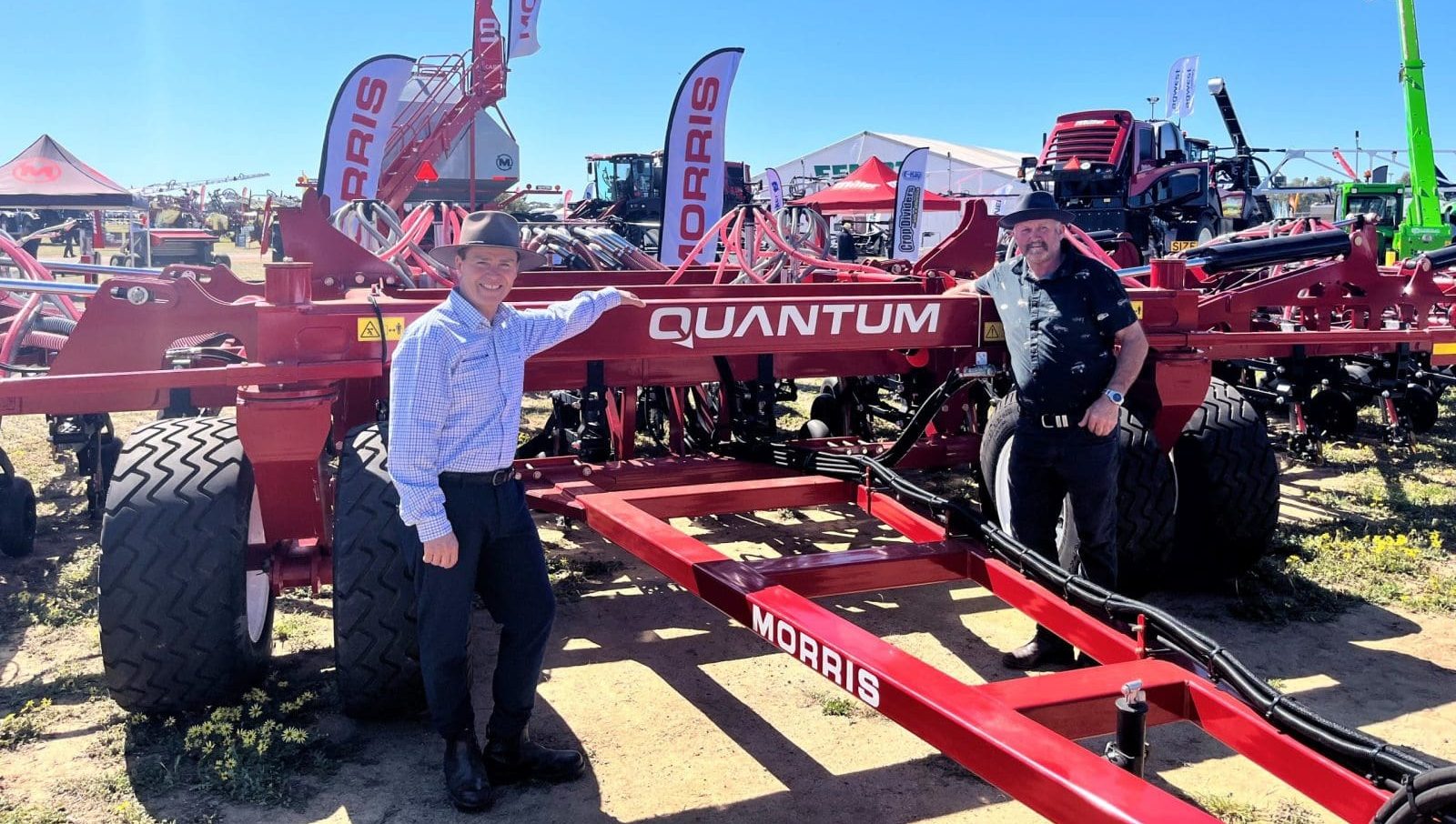
McIntosh Distribution’s Duncan Murdoch looks over a Morris Quantum air drill with Beaumont, WA, grower Darren Inkster at the 2023 Dowerin Machinery Field Days. Photo: McIntosh
WESTERN Australian grower Darren Inkster said timely rainfall contributed to another solid harvest result over the family’s properties, as did an improved seeding system.
The Inksters crop 4600ha to wheat, barley and canola over two properties including their Sparkle Hill home farm, as well as on share-farmed land, all mostly north of Beaumont.
The country ranges from traditional sand over clay on the home farm through to heavy limestone soils further north of Beaumont, and it received 350-450mm of rain last season.
“Even though the season shut off, we generally received rainfall when we wanted it and we had good subsoil moisture after recording 600mm the previous year,” Mr Inkster said.
Grain yield averages at harvest included 3.2 tonnes/ha for the wheat, 3.5t/ha for barley and 1.5t/ha
for canola.
“We enjoyed good opening rains in April and most of the canola was in before Anzac Day.”
Mr Inkster said seeding equipment upgrades in recent years were also playing a key role in the improving
crop production.
“The technology is just getting better and better and it’s probably the reason for the better crops.”
The Inksters have been buying their seeding equipment from local machinery dealer Staines Esperance, and its successor McIntosh & Son.
“Earlier, we went to a hydraulic tyne with a Morris C1 and then C2 contour bar and now we have
an 18m Quantum air drill.”
Mr Inkster identified the Auto-Pack feature on the Quantum air drill as one of the most exciting
technological advances, and said it was easy to operate after becoming familiar with the system.
Morris Auto-Pack automatically adjusts the air drill’s packing pressure according to soil conditions, providing for correctly closed and packed furrows in order to achieve an ideal seedbed environment.
“Morris are always adapting to the Australian market and with the Auto-Pack, you get a good, firm
pack around the seed.
“Those who haven’t got (the technology) will probably be flat out trying to get it.
“Even if it starts to get dry in heavy country, I reckon with the uniform packing around the seed, we are getting better establishment.
“In sandy soils, we have also seen some of the best establishment of canola.”
Improved traction
Mr Inkster said Auto-Lift technology with the Morris Quantum, which allows for automatic lifting and lowering of tynes, made headland turns an easy task.
He said end-of-row turning, which will work in conjunction with their Topcon X35 controller and help
achieve accurate, hands-free turns, would be their next seeding step.
The Inksters have been impressed by the large flotation tyres on the Morris Quantum air drill, also compared with the tandem wheel configuration on their previous C2 Contour bar.
“The C2 wheels used to come off the ground occasionally and we did have some problems with them in wet seasons, but there is no issue with the big Quantum tyres and you hardly even see a footprint. You don’t see where it’s been.”
Set on 25cm tyne spacings and comprising a paired-row seeding-boot arrangement, the air drill has encountered no major concerns with stubble handling.
“It’s actually handled the stubbles a lot better than the C2.”
Mr Inkster said the stainless-steel air kits and plumbing configuration across the bar was another key
strength with the Morris Quantum.
“Someone has spent a lot of time on it, and now with the Raycol heads, rather than a fan system, it
has been much better.”
The narrow folding width of the Quantum air drill also allows safer transport between the Inksters’
properties.
The air drill is hitched to an 18t four-bin Morris 9535 tow-between air cart, allowing for deep banding of urea fertiliser.
The cart completed its seventh season last year and was one of the first from the manufacturer in the region to feature its Input Control Technology to help eliminate seeding overlap and save on seed and fertiliser inputs.
“With our paddocks being not so square and having triangular corners, the section control has been
a big benefit and you can see each section dropping-off as you go.
“We could be saving 5-10 percent on the seed and fertiliser.
“With the rollers and with the section control being independently driven, we’ve hardly had any issues.”
The Morris 9535 air cart is filled from a Tornado 5-in-1 bin or belly dumper via a Brandt conveyor.
The seeding rig is pulled by a New Holland T9.600 tractor and Darren said when they update it, they would also look to upgrade the air cart.
“We want a bin that will do 100ha in daylight hours, and then fil -up for the night with plenty of commodity on board; at the moment, we can do about 70ha.
“We will also move further towards a controlled traffic set-up.”
Source: McIntosh

HAVE YOUR SAY